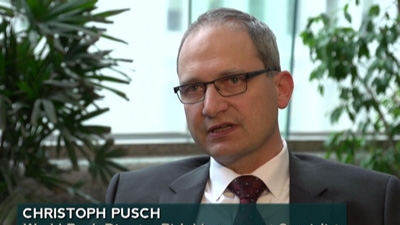Christoph Pusch, the Africa Disaster Risk Management Group Practice Leader, is helping to lead the World Bank Africa Region’s effort to further intensify the focus on the reduction of risks related to disaster events. Working with regional partners, the Group aims to reduce the vulnerability and economic impact of the poorest populations through increased disaster resilience. Christoph believes that In order to achieve the World Bank Group’s goal of ending extreme poverty by 2030, implementing disaster risk management strategies at every level of society is paramount. This includes promoting regional integration and cooperation on disaster risk management, strengthening preparedness and modernizing facilities to improve weather, climate and hydrological forecasting.
He spoke with the Bank's Amelody Lee recently to discuss disaster risk management challenges facing Sub-Saharan Africa and how the Bank is responding.
What types of disaster affect Africa?
Christoph notes that floods, cyclones and drought are the most common forms of disasters in Sub-Saharan Africa and often follow seasonal patterns such as the rainy season in the southern regions and West and drier periods along the Sahel and Horn of Africa. These disasters are compounded by a limited infrastructure, lack of consistent information exchanges and a general lack of institutional response mechanisms. Even non-extreme events can have a large impact on vulnerable areas. The World Bank Africa region is addressing these issues and supports the idea that disaster risk management must be integrated into the main development agenda.
What are hidden disasters?
The agenda in Africa is much different. Hidden disasters are the more frequent events that do not receive wide media coverage. 11 of the most highly vulnerable countries to disaster are located in Africa. This means poorer families exposed to flood or drought can almost certainly never escape from the cycle of poverty. This is the reason why the agenda must be shifted from that of a concentration on emergency response to one more focused on long-term resilience.
How is a risk mitigation strategy created?
It is important to be able to quantify the risks of disasters. This helps to form a risk mitigation strategy and better plan for longer term engagement. Again, this requires a cultural shift both within and beyond the Bank from focusing on emergency responses to disasters to working toward longer term mitigation strategies. The Bank is working to support this through continued dialogue with Governments in order to advance the capacity of dealing with longer term risks.

